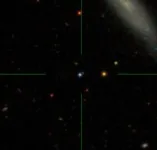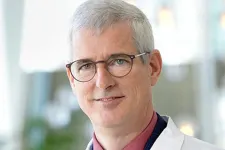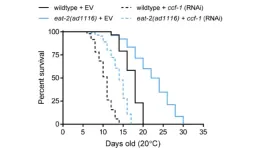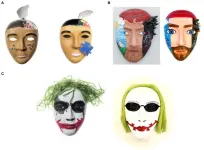(Press-News.org) UNIVERSITY PARK, Pa. — By combining forefront X-ray observations with state-of-the-art supercomputer simulations of the buildup of galaxies over cosmic history, researchers have provided the best modeling to date of the growth of the supermassive black holes found in the centers of galaxies. Using this hybrid approach, a research team led by Penn State astronomers derived a complete picture of black-hole growth over 12 billion years, from the Universe’s infancy at around 1.8 billion years old to now at 13.8 billion years old.
The research comprises two papers, one published in The Astrophysical Journal in April 2024, and one as yet unpublished that will be submitted to the same journal. The results will be presented at the 244th meeting of the American Astronomical Society, held June 9 through June 13 at the Monona Terrace Convention Center in Madison, Wisconsin. The results will also be featured during a press conference that will be livestreamed on Tuesday, June 11, from 2:15 to 3:15 p.m. CDT.
“Supermassive black holes in galaxy centers have millions-to-billions of times the mass of the Sun,” said Fan Zou, a graduate student at Penn State and first author of the papers. “How do they become such monsters? This is a question that astronomers have been studying for decades, but it has been difficult to track all the ways black holes can grow reliably.”
Supermassive black holes grow through a combination of two main channels. They consume cold gas from their host galaxy — a process called accretion — and they can merge with other supermassive black holes when galaxies collide.
“During the process of consuming gas from their hosting galaxies, black holes radiate strong X-rays, and this is the key to tracking their growth by accretion,” said W. Niel Brandt, Eberly Family Chair Professor of Astronomy and Astrophysics and professor of physics at Penn State and a leader of the research team. “We measured the accretion-driven growth using X-ray sky survey data accumulated over more than 20 years from three of the most powerful X-ray facilities ever launched into space.”
The research team used complementary data from NASA’s Chandra X-ray Observatory, the European Space Agency’s X-ray Multi-Mirror Mission-Newton (XMM-Newton), and the Max Planck Institute for Extraterrestrial Physics’ eROSITA telescope. In total, they measured the accretion-driven growth in a sample of 1.3 million galaxies that contained over 8,000 rapidly growing black holes.
“All of the galaxies and black holes in our sample are very well characterized at multiple wavelengths, with superb measurements in the infrared, optical, ultraviolet, and X-ray bands,” Zou said. “This allows for robust conclusions, and the data show that, at all cosmic epochs, more massive galaxies grew their black holes by accretion faster. With the quality of the data, we were able to quantify this important phenomenon much better than in past works.”
The second way that supermassive black holes grow is through mergers, where two supermassive black holes collide and merge together to form a single, even more massive, black hole. To track growth by mergers, the team used IllustrisTNG, a set of supercomputer simulations that model galaxy formation, evolution, and merging from shortly after the Big Bang until the present.
“In our hybrid approach, we combine the observed growth by accretion with the simulated growth through mergers to reproduce the growth history of supermassive black holes,” Brandt said. “With this new approach, we believe we have produced the most realistic picture of the growth of supermassive black holes up to the present day.”
The researchers found that, in most cases, accretion dominated black-hole growth. Mergers made notable secondary contributions, especially over the past 5 billion years of cosmic time for the most-massive black holes. Overall, supermassive black holes of all masses grew much more rapidly when the Universe was younger. Because of this, the total number of supermassive black holes was almost settled by 7 billion years ago, while earlier in the Universe many new ones kept emerging.
“With our approach, we can track how central black holes in the local universe most likely grew over cosmic time,” Zou said. “As an example, we considered the growth of the supermassive black hole in the center of our Milky Way Galaxy, which has a mass of 4 million solar masses. Our results indicate that our Galaxy's black hole most likely grew relatively late in cosmic time.”
In addition to Zou and Brandt, the research team includes Zhibo Yu, graduate student at Penn State; Hyungsuk Tak, assistant professor of statistics and of astronomy and astrophysics at Penn State; Elena Gallo at the University of Michigan; Bin Luo at Nanjing University in China; Qingling Ni at the Max Planck Institute for Extraterrestrial Physics in Germany; Yongquan Xue at the University of Science and Technology of China; and Guang Yang at the University of Groningen in the Netherlands.
Funding from the U.S. National Science Foundation, the Chandra X-ray Center, and Penn State supported this work. The work was also made possible by the sharing of the IllustrisTNG simulation results with the scientific community.
END
How do supermassive black holes get super massive?
Combined X-ray surveys and supercomputer simulations track 12 billion years of cosmic black-hole growth
2024-06-11
ELSE PRESS RELEASES FROM THIS DATE:
Pilot study in JNCCN explores new approach for reducing anxiety and improving quality of life after stem cell transplantation
2024-06-11
PLYMOUTH MEETING, PA [June 11, 2024] — New research in the June 2024 issue of JNCCN—Journal of the National Comprehensive Cancer Network highlights a promising approach for alleviating distress, enhancing quality of life, improving physical function, and reducing fatigue in patients with blood cancers who undergo hematopoietic stem cell transplantation (HSCT). The study used a randomized clinical trial to evaluate the feasibility of a nine-week, phone-delivered, positive psychology program called Positive Affect for the Transplantation of ...
Controlling the precise timing of electrical pulses may offer promise for treating mild traumatic brain injury
2024-06-11
An awkward beat doesn't help on the dance floor, but it could help people who are recovering from mild traumatic brain injury (mTBI).
Publishing online today (June 11, 2024) in the Journal of Neurotrauma, Virginia Tech scientists with the Fralin Biomedical Research Institute at VTC show that specifying the timing pattern of neurostimulation – impulses used to activate the brain’s own electrical signaling mechanisms – can rebalance the strength of synaptic connections between nerve cells, selectively up- or down-regulating those connections. While the timing pattern of electrical signaling is important in the normal brain, ...
Scientists engineer yellow-seeded camelina with high oil output
2024-06-11
UPTON, N.Y. — Efforts to achieve net-zero carbon emissions from transportation fuels are increasing demand for oil produced by nonfood crops. These plants use sunlight to power the conversion of atmospheric carbon dioxide into oil, which accumulates in seeds. Crop breeders interested in selecting plants that produce a lot of oil look for yellow seeds. In oilseed crops like canola, yellow-seeded varieties generally produce more oil than their brown-seeded counterparts. The reason: The protein responsible for brown seed color — which yellow-seeded plants lack — also plays a key role in oil production.
Now, plant biochemists at the U.S. Department of Energy’s (DOE) Brookhaven ...
Specialist and migratory birds at greater risk under climate change
2024-06-11
URBANA, Ill. -- Following decades of decline, even fewer birds will darken North American skies by the end of the century, according to a new analysis by scientists at the University of Illinois Urbana-Champaign. Their study is the first to examine the long-term effects of climate change on the abundance and diversity of bird groups across the continent as a whole while accounting for additional factors that put birds at risk, such as pesticides, pollution, land use change, and habitat loss.
“Many studies try to attribute causes like climate ...
New biomarker database designed to improve astronaut health may also be useful to earthlings
2024-06-11
As space travel becomes more frequent, a new biomarker tool was developed by an international team of researchers to help improve the growing field of aerospace medicine and the health of astronauts.
Dr. Guy Trudel (Professor in the Faculty of Medicine), Odette Laneuville (Associate Professor, Faculty of Science, and Director of the Biomedical Sciences) and Dr. Martin Pelchat (Associate Professor in the Department of Biochemistry, Microbiology and Immunology) are among the contributors to an international ...
Haiku may shine a light on humans’ relationship with insects, study suggests
2024-06-11
UNIVERSITY PARK, Pa. — Haiku poems have reflected humans’ experiences in nature for hundreds of years, including observations of bugs and other wildlife. Recently, Penn State researchers analyzed which insects were mentioned the most in haiku — with butterflies, fireflies and singing insects such as crickets topping the list.
Haiku are three-line poems with five syllables in the first and third lines, and seven syllables in the second line.
In their study of nearly 4,000 haiku, recently published in the journal PLOS ONE, the researchers also found that aquatic arthropods — such as caddisflies, stoneflies and fishflies — were mentioned the ...
CCR4-NOT complex in stress resistance and longevity in C. elegans
2024-06-11
“[...] it appears that the CCR4-NOT complex can influence longevity in a multitude of manners [...]”
BUFFALO, NY- June 11, 2024 – A new editorial paper was published in Aging (listed by MEDLINE/PubMed as "Aging (Albany NY)" and "Aging-US" by Web of Science) Volume 16, Issue 10, entitled, “CCR4-NOT complex in stress resistance and longevity in C. elegans.”
The ability to mount an adaptive response to environmental stress is crucial in organismal survival and overall fitness. In the context of aging, many genes that mediate resistance to stressors are also important in longevity, and aging has been shown to cause ...
Workforce agreement supports local labor for Oakland Hospital
2024-06-11
Subscribe to UCSF News
Note to Editors: Speaker bios are available in our media kit
UCSF Health and UCSF Benioff Children’s Hospitals celebrated the signing of a Community Workforce Agreement (CWA) on June 11, agreeing to prioritize local union workers for the construction of a proposed landmark hospital building and related site improvements on its Oakland site.
The agreement, signed by the Building and Construction Trades Council of Alameda County (BTCA) and the project’s general contractor, Rudolph and Sletten, confirms a mutual understanding to hire union workers and follow union hiring practices. An additional agreement was signed by Overaa Construction, ...
Female AI ‘teammate’ generates more participation from women
2024-06-11
ITHACA, N.Y. – An artificial intelligence-powered virtual teammate with a female voice boosts participation and productivity among women on teams dominated by men, according to new Cornell University research.
The findings suggest that the gender of an AI’s voice can positively tweak the dynamics of gender-imbalanced teams and could help inform the design of bots used for human-AI teamwork, researchers said.
The findings mirror previous research that shows minority teammates are more likely to participate if the team adds members similar to them, said Angel Hsing-Chi Hwang, postdoctoral associate in information science and ...
Do traumatic life experiences impact perception of distressing imagery?
2024-06-11
The human visual system is a dominant part of the brain’s processes and navigation of the world. To better understand an aspect of this system, researchers from Drexel University’s College of Nursing and Health Professions examined how life experiences impact a person’s perception of imagery – specifically decorated masks.
The study, published in Frontiers in Psychology, examined viewer responses to images of distressing and neutrally decorated masks and whether personal life history, particularly past ...
LAST 30 PRESS RELEASES:
Making lighter work of calculating fluid and heat flow
Normalizing blood sugar can halve heart attack risk
Lowering blood sugar cuts heart attack risk in people with prediabetes
Study links genetic variants to risk of blinding eye disease in premature infants
Non-opioid ‘pain sponge’ therapy halts cartilage degeneration and relieves chronic pain
AI can pick up cultural values by mimicking how kids learn
China’s ecological redlines offer fast track to 30 x 30 global conservation goal
Invisible indoor threats: emerging household contaminants and their growing risks to human health
Adding antibody treatment to chemo boosts outcomes for children with rare cancer
Germline pathogenic variants among women without a history of breast cancer
Tanning beds triple melanoma risk, potentially causing broad DNA damage
Unique bond identified as key to viral infection speed
Indoor tanning makes youthful skin much older on a genetic level
Mouse model sheds new light on the causes and potential solutions to human GI problems linked to muscular dystrophy
The Journal of Nuclear Medicine ahead-of-print tip sheet: December 12, 2025
Smarter tools for peering into the microscopic world
Applications open for funding to conduct research in the Kinsey Institute archives
Global measure underestimates the severity of food insecurity
Child survivors of critical illness are missing out on timely follow up care
Risk-based vs annual breast cancer screening / the WISDOM randomized clinical trial
University of Toronto launches Electric Vehicle Innovation Ontario to accelerate advanced EV technologies and build Canada’s innovation advantage
Early relapse predicts poor outcomes in aggressive blood cancer
American College of Lifestyle Medicine applauds two CMS models aligned with lifestyle medicine practice and reimbursement
Clinical trial finds cannabis use not a barrier to quitting nicotine vaping
Supplemental nutrition assistance program policies and food insecurity
Switching immune cells to “night mode” could limit damage after a heart attack, study suggests
URI-based Global RIghts Project report spotlights continued troubling trends in worldwide inhumane treatment
Neutrophils are less aggressive at night, explaining why nighttime heart attacks cause less damage than daytime events
Menopausal hormone therapy may not pose breast cancer risk for women with BRCA mutations
Mobile health tool may improve quality of life for adolescent and young adult breast cancer survivors
[Press-News.org] How do supermassive black holes get super massive?Combined X-ray surveys and supercomputer simulations track 12 billion years of cosmic black-hole growth







